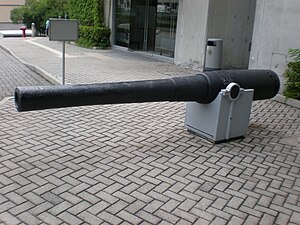BL 5 inch gun Mk I - V
| Ordnance BL 5 inch gun Mks I - V | |
|---|---|

Mk I coast defence gun outside entrance to the Hong Kong Museum of Coastal Defence
|
|
| Type |
Naval gun Coast defence gun Field gun |
| Service history | |
| In service | 1880 - 1947? |
| Used by | United Kingdom |
| Wars | Second Boer War |
| Production history | |
| Variants | Mks I - V |
| Specifications | |
| Weight | Mk I - II : 38 long hundredweight (1,930 kg) Mk III - V : 40 long hundredweight (2,030 kg) |
| Barrel length | 125 inches (3,175 mm) bore (25 calibres) |
|
|
|
| Shell | 50 pounds (22.68 kg) |
| Calibre | 5-inch (127.0 mm) |
| Breech | de Bange |
| Muzzle velocity | 1,750 feet per second (533 m/s) |
| Maximum firing range | 8,700 yards (8,000 m) |
The BL 5 inch guns Mk I - Mk V were early British 5-inch rifled breechloading naval guns after it switched from rifled muzzle-loaders in the late 1870s. They were originally designed to use the old gunpowder propellants. The 5-inch calibre was soon discontinued in favour of QF 4.7-inch.
Guns equipped the following British warships :
These guns also equipped several small gunboats of Colonial navies of Australia in the 1880s in response to the perceived threat of Russian expansionism in the Pacific (The "Russian scares").
A number of guns mounted on carriages from obsolete RML 40 pounder guns accompanied the British siege train (heavy artillery) to South Africa. They were not required for the expected siege of Pretoria, which did not eventuate. Its usefulness in the field was limited by lack of a recoil control system, and the QF 4.7 inch gun was the most commonly used British heavy gun in the war.
The gun was installed as a conventional coast defence gun in South Africa and Australia, and several in the United Kingdom. Its more common use ashore in the UK was as "moveable armaments" in forts : on 2-wheeled carriages similar to field carriages but intended only for moving short distances to position guns for defence of the fort. These used either obsolete 40-pounder RML carriages or special high-mounting carriages for firing over parapets with recoil controlled by a hydraulic buffer built into the platform to which the carriage was fastened.
...
Wikipedia
